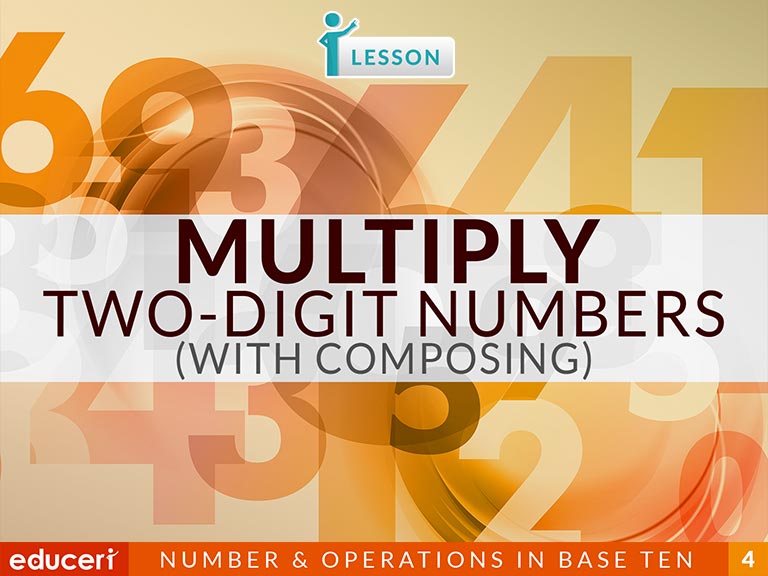All Lessons

Write Multi-Digit Numbers Using Expanded Form
Share This Lesson

Compare Multi-Digit Numbers
This number and operations in base ten lesson teaches students how to compare the value of multi-digit numbers. The lesson includes research-based strategies and strategic questions that prepare students for assessments. In this lesson, students determine which of a pair of multi-digit numbers is larger. The focus of this lesson is reinforcing differences between numbers based on place value.
Share This Lesson
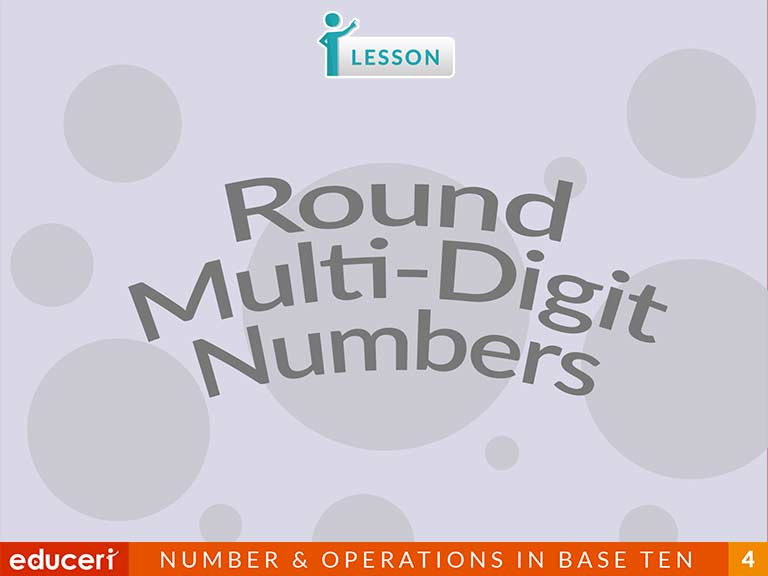
Round Multi-Digit Numbers
This number and operations in base ten lesson teaches students how to round multi-digit numbers. The lesson includes research-based strategies and strategic questions that prepare students for assessments. In this lesson, students will round multi-digit numbers to a variety of place values. The focus of this lesson is to look at the relationship between the values of numbers. This lesson uses a variety of strategies including number lines to visualize the number being rounded to.
Share This Lesson

Add Multi-Digit Numbers (with Composing)
This number and operations in base ten lesson teaches students how to add multi-digit numbers. The lesson includes research-based strategies and strategic questions that prepare students for assessments. In this lesson, students will extend their knowledge of multi-digit addition by adding numbers up to the hundred thousands. Students will apply the standard addition algorithm with a focus on correctly lining up the numbers by place value and composing tens correctly. This lesson also contains real-world examples for students to practice with.
Share This Lesson

Subtract Multi-Digit Numbers (with Decomposing)
This number and operations in base ten lesson teaches students how to subtract multi-digit numbers. The lesson includes research-based strategies and strategic questions that prepare students for assessments. In this lesson, students will extend their knowledge of multi-digit subtraction by adding numbers up to the hundred thousands. Students will apply the standard addition algorithm with a focus on correctly lining up the numbers by place value and decomposing digits correctly. This lesson also contains real-world examples for students to practice with.
Share This Lesson
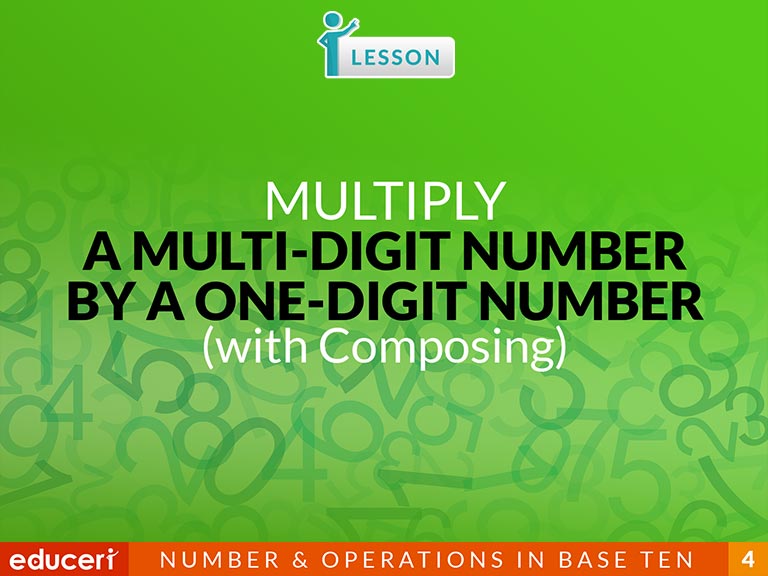
Multiply a Multi-Digit Number By a One-Digit Number (with Composing)
This number sense lesson focuses on multiplying numbers with regrouping. The lesson includes research-based strategies and questions that help prepare students for assessments. In this lesson, students multiply the bottom number with each digit of the top number, regrouping if needed (add the regrouped number, if needed). Then, they read the product aloud. In addition to the lesson, there are four pages of Independent Practice and review with questions modeled after current adaptive testing items.
Share This Lesson

Divide Multi-Digit Numbers By a One-Digit Number (with Remainders)
This number sense lesson focuses on solving division problems that have a remainder. The lesson includes research-based strategies and questions that help prepare students for assessments. In this lesson, students identify the dividend and the divisor. Then, they solve for the division problem by following the basic steps of division (divide, multiply, subtract, and bring down) and writing in the remainder. Finally, students interpret the quotient and remainder. In addition to the lesson, there are eight pages of Independent Practice and review with questions modeled after current adaptive testing items.
Share This Lesson
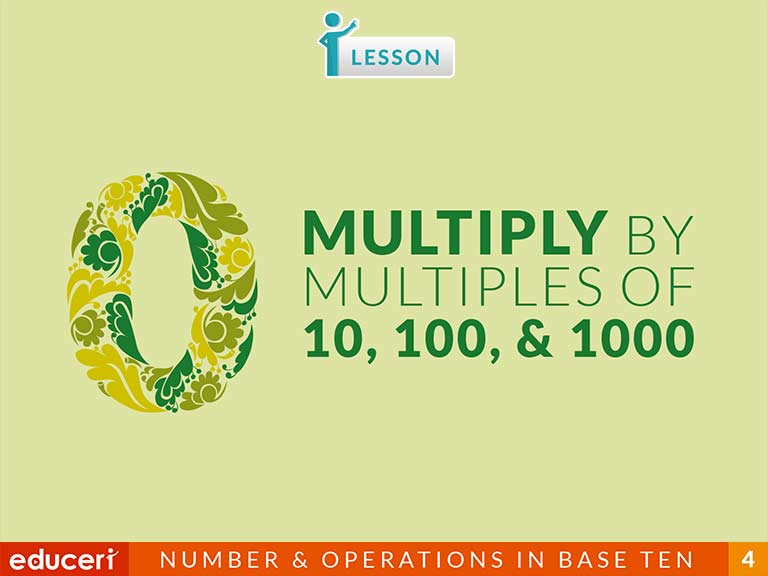
Multiply by Multiples of 10, 100, and 1000
This number and operations in base ten lesson teaches students how to multiply numbers by multiples of 10, 100, and 1,000. The lesson includes research-based strategies and strategic questions that prepare students for assessments. In this lesson, students will multiply numbers by multiples of 10, 100, and 1,000 and multiples of 10 by multiples of 10 in preparation for more complex multi-digit multiplication in the future. This lesson focuses on the simplification of complex multiplication problems into simpler ones to facilitate relatively easy multiplication.
Share This Lesson

Order Whole Numbers (Thousands Place)
This number sense lesson focuses on ordering whole numbers. The lesson includes research-based strategies and questions that help prepare students for assessments. In this lesson, students read the problem and write the numbers in the place value chart. Then, they compare the digits with the same place value and write the digits in order. In addition to the lesson, there are four pages of Independent Practice and review with questions modeled after current adaptive testing items.
Share This Lesson
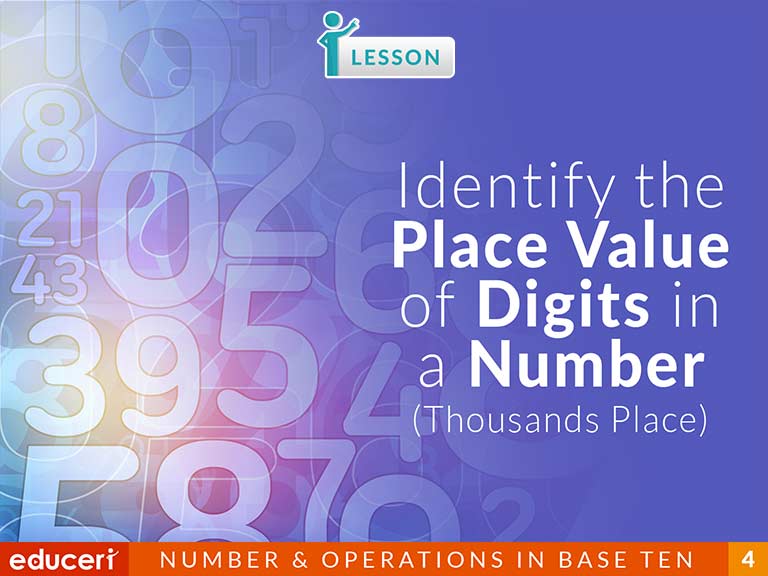
Identify Place Value of Digits in a Number (Thousands Place)
This number sense lesson focuses on identifying the place value of digits in a number. The lesson includes research-based strategies and questions that help prepare students for assessments. In this lesson, students identify a specific digit in a number and identify the place of the digit. Then, they identify the value of the digit. In addition to the lesson, there are four pages of Independent Practice and review with questions modeled after current adaptive testing items.
Share This Lesson

Use Expanded Form (Thousands Place)
This number sense lesson focuses on using expanded form to represent numbers. The lesson includes research-based strategies and questions that help prepare students for assessments. In this lesson, students read the number aloud and identify and label the digit in the ones, tens, hundreds, and thousands place. Then, they write the number in expanded form. In addition to the lesson, there are expanded form flashcards and four pages of Independent Practice and review with questions modeled after current adaptive testing items.
Share This Lesson

Use the Relationship Between Multiplication & Division
4.NBT.5 Multiply a whole number of up to four digits by a one-digit whole number, and multiply two two-digit numbers, using strategies based on place value and the properties of operations. Illustrate and explain the calculation by using equations, rectangular arrays, and/or area models.
4.NBT.64.NBT.6 Find whole-number quotients and remainders with up to four-digit dividends and one-digit divisors, using strategies based on place value, the properties of operations, and/or the relationship between multiplication and division. Illustrate and explain the calculation by using equations, rectangular arrays, and/or area models.
This number sense lesson focuses on using the relationship between multiplication and division to check answers. The lesson includes research-based strategies and questions that help prepare students for assessments. In this lesson, students identify the operation needed to check the answer. Then, they set up the multiplication or division problem and identify the numbers used to create the problem. Finally, students check the answer by solving the problem. In addition to the lesson, there are four pages of Independent Practice and review with questions modeled after current adaptive testing items.
Share This Lesson
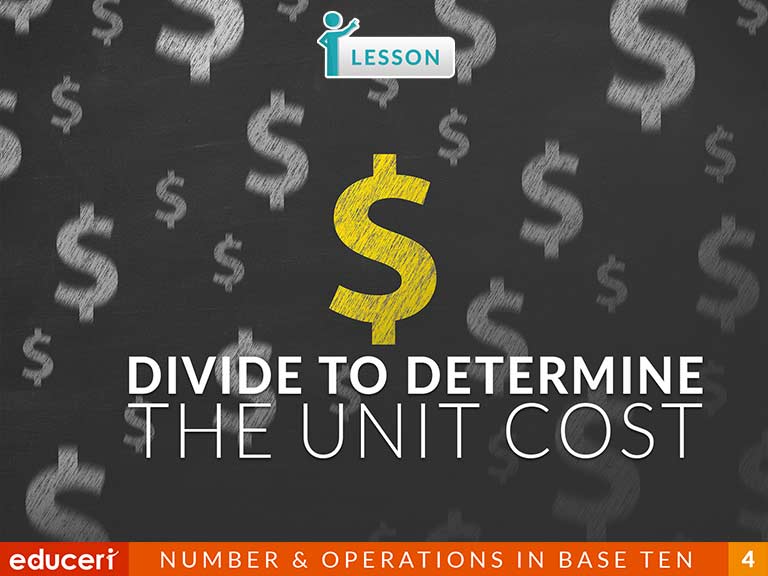
Divide to Determine the Unit Cost
This number sense lesson focuses on determining the unit cost. The lesson includes research-based strategies and questions that help prepare students for assessments. In this lesson, students read the problem and identify the number of units and the total cost. Then, they set up the division problem using the number of units and total cost, and solve the division problem. In addition to the lesson, there are eight pages of Independent Practice and review with questions modeled after current adaptive testing items.
Share This Lesson

Order Whole Numbers (Millions Place)
This number sense lesson focuses on ordering whole numbers. The lesson includes research-based strategies and questions that help prepare students for assessments. In this lesson, students first write the numbers into the grid. Then, they find the least and greatest numbers of the set by comparing the digits of the numbers (label as "least" and "greatest"). Finally, students write the numbers in order from least to greatest, then greatest to least. In addition to the lesson, there are nine pages of Independent Practice and review with questions modeled after current adaptive testing items.
Share This Lesson

Convert Between Fractions and Division Problems
This number sense lesson focuses on converting between fractions and division problems. The lesson includes research-based strategies and questions that help prepare students for assessments. In this lesson, students represent each fraction with the division symbol. Then, they solve the problem using multiplication facts or with long division, if necessary. In addition to the lesson, there are four pages of Independent Practice and review with questions modeled after current adaptive testing items.
Share This Lesson

Subtract Whole Numbers (Standard Algorithm)
This number sense lesson focuses on subtracting whole numbers. The lesson includes research-based strategies and questions that help prepare students for assessments. In this lesson, students read the subtraction problem and line up the numbers by their place value. Then, they subtract each column (starting from the right) and regroup, if needed. Finally, students interpret the difference. In addition to the lesson, there are four pages of Independent Practice and review with questions modeled after current adaptive testing items.
Share This Lesson

Explain Multiplication Using Area Models
4.NBT.5 Multiply a whole number of up to four digits by a one-digit whole number, and multiply two two-digit numbers, using strategies based on place value and the properties of operations. Illustrate and explain the calculation by using equations, rectangular arrays, and/or area models.
4.NBT.64.NBT.6 Find whole-number quotients and remainders with up to four-digit dividends and one-digit divisors, using strategies based on place value, the properties of operations, and/or the relationship between multiplication and division. Illustrate and explain the calculation by using equations, rectangular arrays, and/or area models.
This number sense lesson focuses on using the relationship between multiplication and division to check answers. The lesson includes research-based strategies and questions that help prepare students for assessments. In this lesson, students write both factors in expanded form. Then, they set up the box model to perform multiplication in. Then, students find the answer by adding up all the box values. In addition to the lesson, there are four pages of Independent Practice and Periodic Reviews with questions modeled after current adaptive testing items.
Share This Lesson

Add Fractions with Like Denominators
This number and operations -- fractions lesson teaches students how to add fractions with like denominators. The lesson includes research-based strategies and strategic questions that prepare students for assessments. In this lesson, students will add fractions with like denominators. This lesson includes a variety of real-world examples. This lesson also covers reducing fractions.

